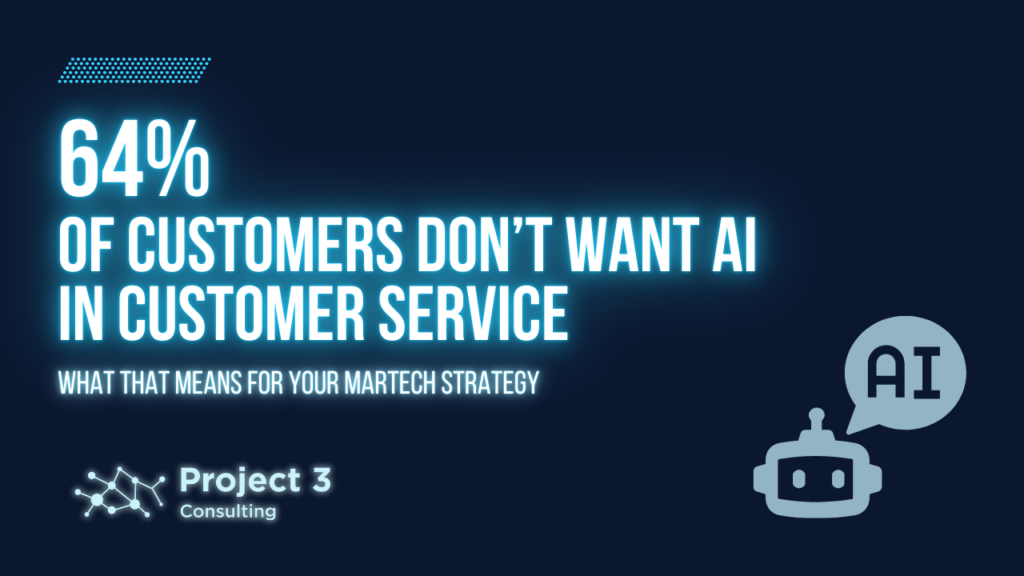
A recent Gartner survey found that 64% of customers would prefer that companies don’t use AI in customer service. As businesses increasingly rely on AI-driven MarTech tools, this presents a dilemma: how can you leverage AI without alienating your customers?
Let’s explore how to strike the right balance when integrating AI into your MarTech strategy.
What Customers Are Concerned About
Customers’ top concerns about AI in customer service include:
- Difficulty Reaching a Person: Many customers worry that AI will make it harder to speak with a real person when they need help. After all, we’ve all experienced the frustration of dealing with a chatbot that can’t address our specific issues.
- Job Displacement: There’s a fear that AI will take over jobs, making customer service less personal. This could lead to backlash against companies implementing AI tools on their websites.
- Incorrect Answers: AI isn’t infallible. Instances of AI providing wrong information are quite common, leading customers to doubt its reliability.
These concerns indicate that while AI can offer efficiency, it’s not always aligned with what customers want.
The Impact on MarTech Strategies
Ignoring these customer preferences could have serious consequences, such as losing customer trust and loyalty. For instance, platforms like HubSpot and Zendesk have integrated AI features to streamline customer interactions. However, if these tools make it difficult for customers to reach a human agent, the AI could backfire, leading to dissatisfaction and higher churn rates.
Consider this scenario: Stacey is exploring a marketing analytics platform and has a question, but the AI bot fails to provide a satisfactory answer. Frustrated, she navigates to a competitor’s site, where she connects with a live person and gets her answer within minutes. After her positive and informative experience, she chooses the second platform.
Customers appreciate the live touch, and this scenario illustrates that over-reliance on AI can deter potential customers.
Finding the Right Balance with AI
To effectively use AI in your MarTech strategy without alienating your audience, consider these approaches:
- Transparency: Platforms like Intercom use AI-driven chatbots to handle simple inquiries but clearly offer customers the option to speak with a human if needed. This builds trust and ensures that customers feel in control of their experience.
- Real-time insights: Platforms like Qualtrics and Salesforce use AI-driven tools to handle simple inquiries and provide real-time insights to customer service agents. For instance, Qualtrics AI can analyze customer feedback in real-time and generate personalized follow-up questions during a survey, helping to gather more detailed insights. It also offers the option to escalate interactions to a human agent when necessary, ensuring customers feel supported and enhancing the human touch in their experience.
- Customer Choice: Allow customers to choose whether they interact with AI or a human. For example, Drift’s conversational marketing platform gives users the option to escalate to a live agent if the bot can’t answer their question.

Practical Steps for Marketers
Here’s how you can integrate AI into your MarTech stack without compromising customer satisfaction:
Train Your Team: Ensure your team is equipped to handle AI-driven interactions. Tools like Adobe Experience Cloud offer training resources to help staff seamlessly integrate AI into their workflows. For instance, if you’re introducing Salesforce Einstein for lead scoring, but your team is unfamiliar with AI tools, Adobe’s training modules can bridge the gap. This training covers both technical aspects and best practices, enabling your team to leverage AI for better lead prioritization and personalized customer interactions.
Evaluate Customer Needs: Before adopting AI, assess whether it aligns with your customers’ preferences. If they value human interaction, opt for AI tools that complement rather than replace it. For example, use AI to handle routine tasks like password resets or order status updates but ensure complex issues are quickly routed to live agents. This maintains the personal connection while benefiting from AI’s efficiency.
Test and Adjust: Implement A/B testing to gauge customer responses to AI-driven features. Suppose you use Optimizely for this purpose. You might discover that while AI recommendations boost average order value, some customers prefer manually curated suggestions. Based on these insights, adjust your strategy to prominently feature AI recommendations while allowing customers to toggle between AI and manual options. This ensures you cater to diverse preferences while maximizing AI benefits.
Conclusion: Putting Your Customers First
With the surge in AI adoption, it’s tempting to prioritize efficiency and innovation over the customer experience. However, as the Gartner survey highlights, a majority of customers still value human interaction with brands. Overlooking this can create a disconnect between your technological offerings and your customers’ true desires.
The successful integration of AI into your MarTech strategy rests on one fundamental principle: putting your customers’ preferences first. By selecting the right platforms and balancing AI with the human touch, you can enhance satisfaction and foster lasting loyalty.
If you’re looking to implement AI in your MarTech stack while keeping your customers happy, Project 3 Consulting is here to help. Let’s discuss how we can tailor your strategy to meet your customers’ needs.




